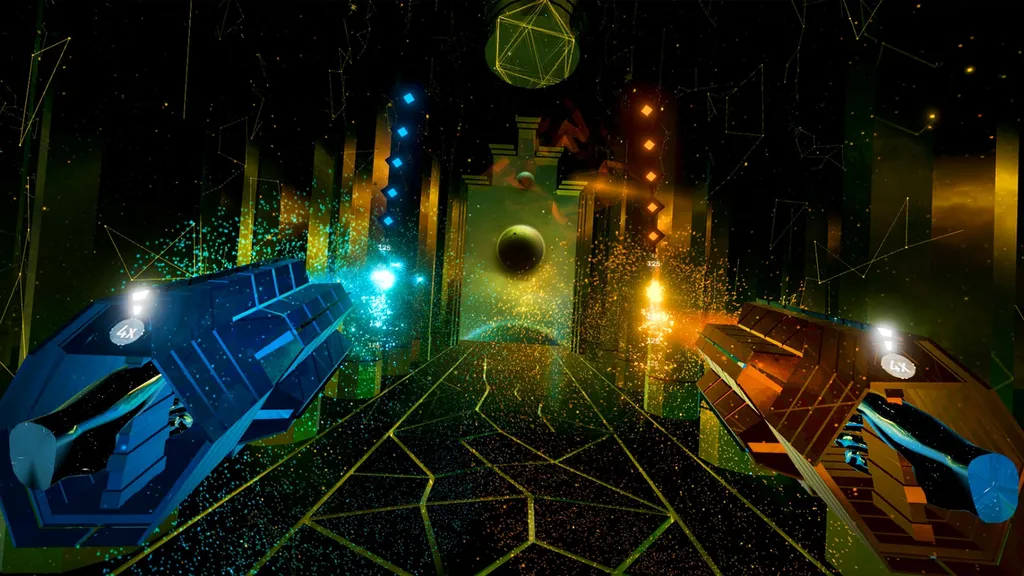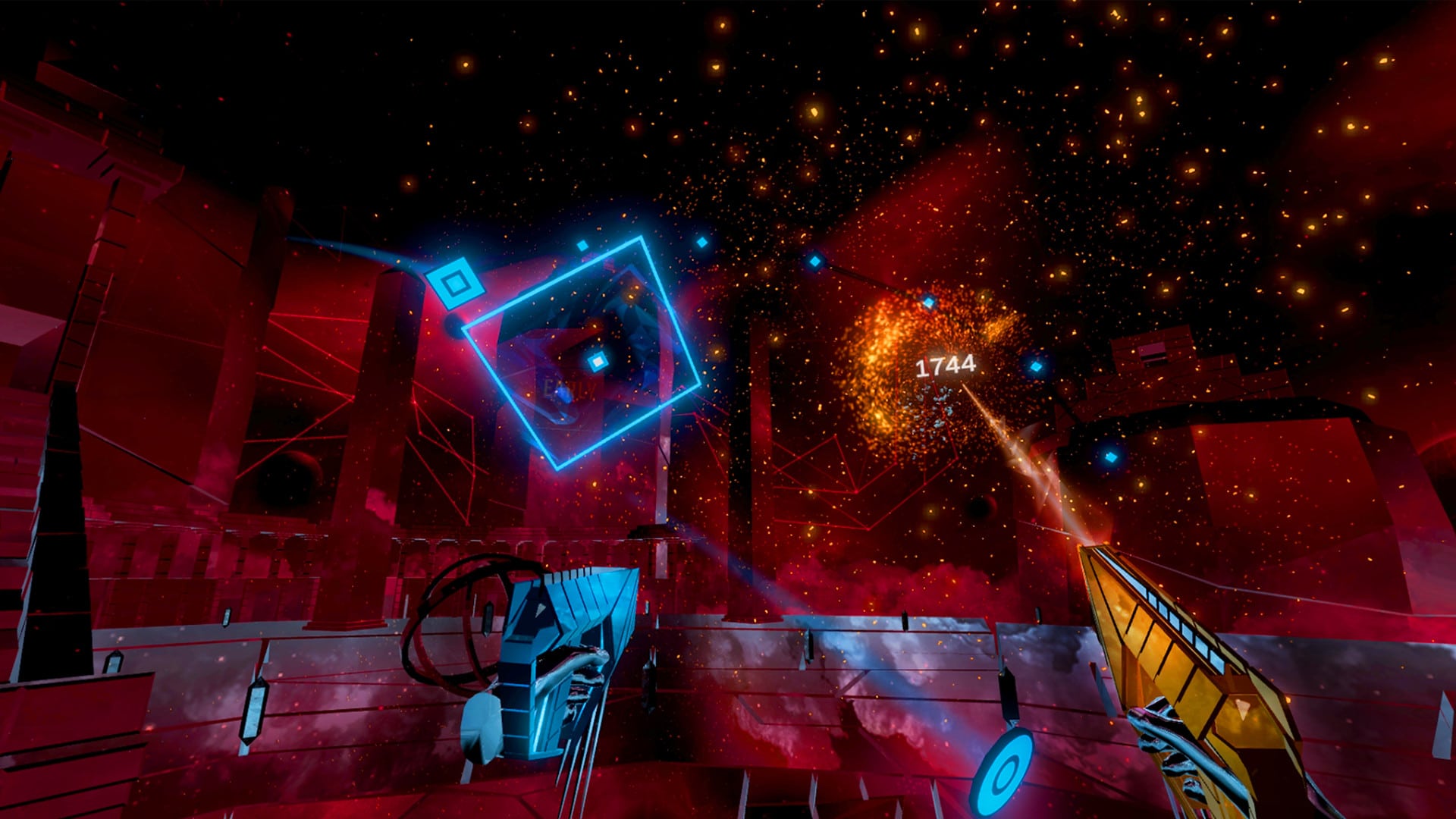Now that Audica has officially launched on Oculus Quest and is available on PSVR and PC VR headsets, we thought it was the perfect time to revisit our review and update it for the current version of the game with a finalized score.
When Audica first hit Early Access it was early 2019 and Beat Saber fever was still in full sing. Beat Saber was absolutely the VR shot heard around the world and clearly Harmonix was listening closely.
To their credit, they have the most experience with crafting music games out of anyone on the planet. They’ve established their legacy as the music game creation game company with titles like Amplitude, Rock Band, and Dance Central to their credit, not to mention VR games like Rock Band VR, Singspace, Dance Central VR, and even Harmonix Music VR, so it’s no wonder they took note. Since then, Pistol Whip has burst onto the scene as another rhythm-based VR shooter, but that one is its own beat entirely.
Comparing Audica to Beat Saber is inevitable, but it has just as many differences as it does similarities. It definitely offers something distinct and different, but not necessarily better. The relatively unwieldy mechanics and lack of overall fluidity makes it harder to recommend than its main competitor’s dead simple pick-up-and-play approach — but let’s dig into the specifics more clearly.
The basic premise in Audica is that you shoot blue and orange nodes inside VR using motion controllers to the beat of the music. Instead of slicing boxes, punching orbs, or blocking objects, you shoot colorful targets. It’s just different enough to feel unique and challenging, obviously requiring a different type of hand-eye coordination than physically punching or swinging. And when you nail it and rack up a huge combo, it feels extremely satisfying.
Once you get in the zone Audica has a way of feeling almost more like a dance than anything else. You’re not only aiming at targets as boxes close in on the center, but also swinging your arms to swat down orbs trying to hit you and scanning the field with your head to locate the next target. The way the game engaged my head and forced me to move and look somewhere other than straight ahead was definitely an adjustment for games like this. We’ve yet to really see a rhythm music game in VR that takes full advantage of the 360 space, other than 360 levels in Beat Saber, but playing Audica on Quest definitely had me looking from left to right constantly.
When you watch footage of this game it’s a bit hard to tell the nuances of each movement, but there are actually a lot of different ways to shoot a target in Audica. There are basic shots with circle targets, diamond shaped shots that require holding the trigger to channel electricity, as well as dual combo shots, chain shots that require tracing a pattern while holding the trigger, as well as both vertical and horizontal shots. It’s a lot to digest.
Even though the tutorial throws everything at you quickly the actual difficulty stages are pretty diverse. In Audica you have entire new game mechanics to contend with depending on which setting you pick which really does help make it feel like a progression within the game rather than notes just moving more quickly.
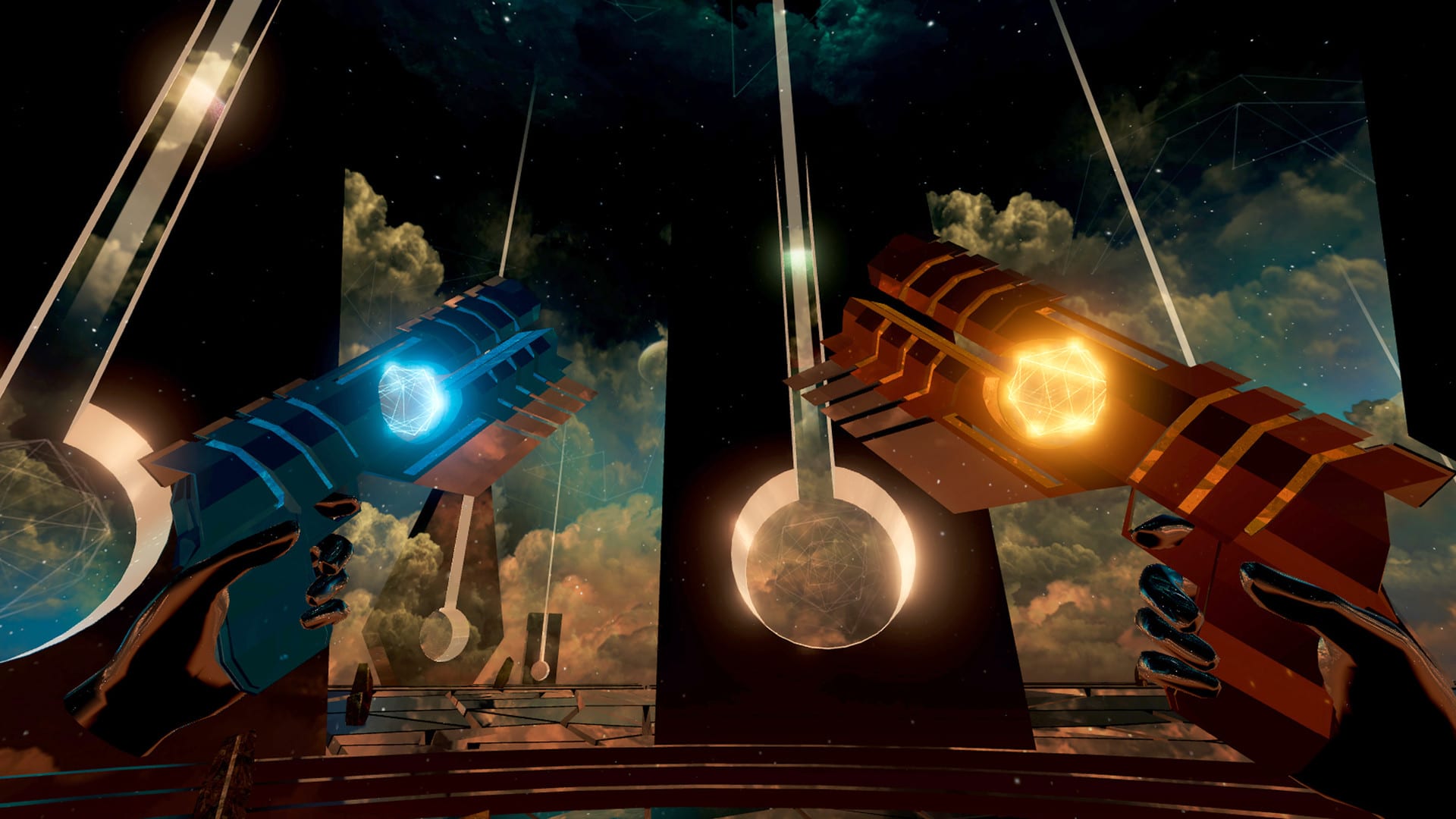
As it turns out, gameplay is actually very similar to an obscure downloadable rhythm game you may not have heard of called Osu which involves dragging your cursor through circles as they shrink and timing it as the outer circle hits the center. Or like in Elite Beat Agents for DS. Basically that, but in VR and with two guns.
I think my main issue with the core gameplay loop is that it doesn’t feel as fine-tuned as it should. For example, with modern VR headsets like the Rift S and Quest, the main two I’ve played this game on, it’s easier than I’d like to miss new targets because of the narrow field of view relative to my actual eyesight. Frequently on the second difficulty tier and above, new targets will appear outside of the headset’s vision. The only indication that a target is there is a faint aura that emanates just before it appears but if you’re turning your head or already looking at an existing target it’s way too easy to miss it. A headset with a wider field of view would help, but I only tried it on Quest and Rift S for this review. It becomes less of a music rhythm game and more of a “quick reflex reaction time” game.
However, the main thing Audica has going for it is a deep and varied selection of songs — especially if you factor in the DLC as well. When you buy the game you’ll immediately have access to over 30 tracks right off the bat ranging from EDM and electronic tracks, as is customary in this genre, but also with a few pop songs and even some metal via Dragonforce thrown in for good measure. They don’t all fit the gameplay that well as far as I’m concerned, but everyone vibes with music differently.
If you add in the DLC, which is reasonably priced at $2 per track or $19.99 for the whole 2019 Season Pass, you get even more variety with artists like Ariana Grande, Billie Eilish, Imagine Dragons, Post Malone, Fall Out Boy, and more. Having that much to pick from is really, really nice and new track releases happen very consistently.
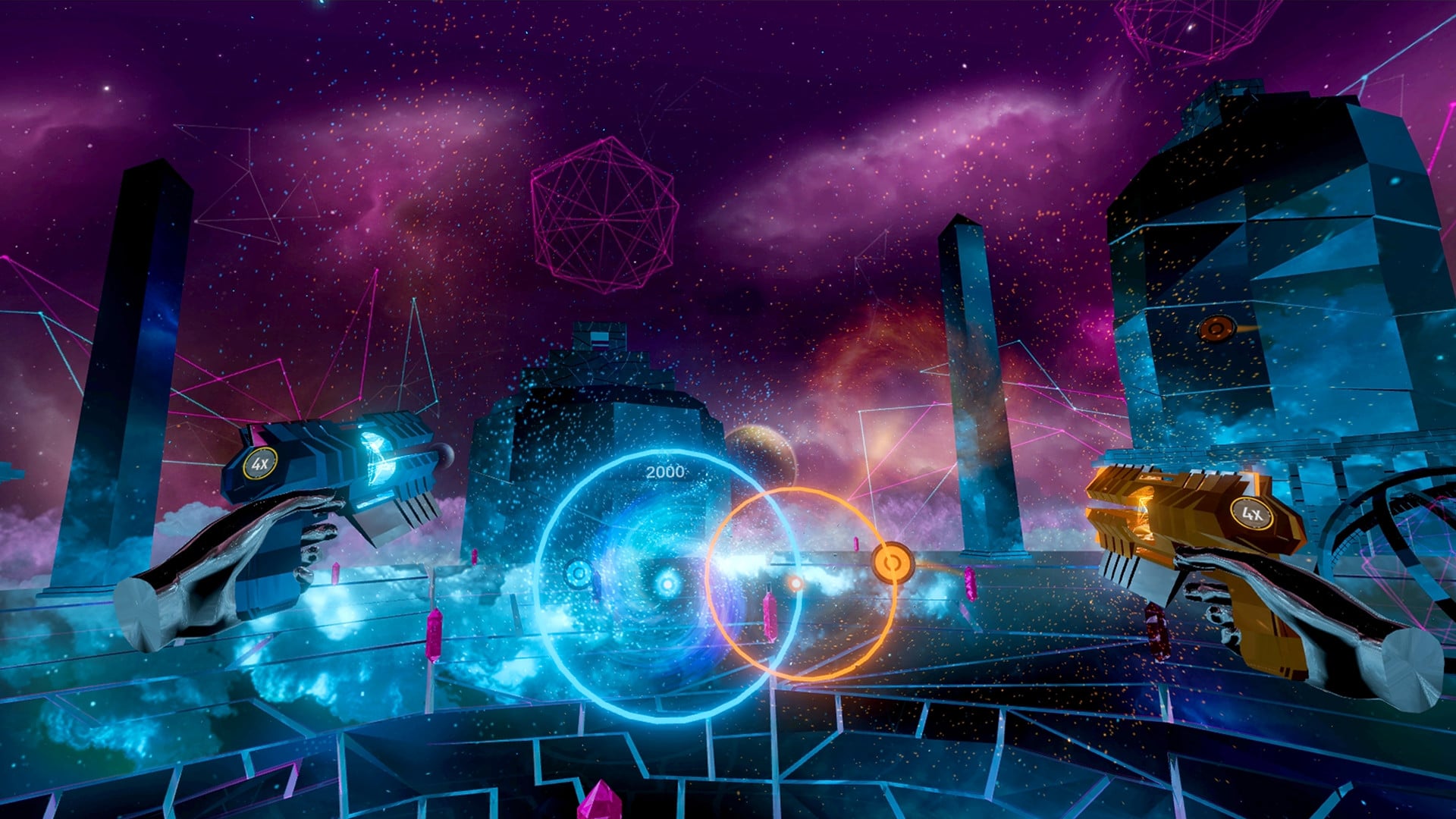
Another issue is that the key action you’re performing (quickly aiming at and shooting targets) doesn’t feel natural. Usually when you shoot a gun in real life or in other VR games you’re holding it up, arms steady, and taking aim carefully or at least with some stability. On the contrary in Audica your arms are swimming through the air, almost like you’re in a ballet, as you swat away objects and quickly take aim at new targets just as they appear. However, this does foster a need to memorize the song patterns and it becomes a much more skillful game, which will appeal to hardcore players. The skill ceiling feels enormous here.
The pure physicality of hitting things though, the cornerstone of what makes so many VR rhythm games addictive, is all but missing. Pointing and pulling a trigger just isn’t as satisfying as the impact of slashing or punching. Even other shooting games like Pistol Whip manage to be more visceral because of the dodging and active nature. In Audica, you basically just stand still. In this way, it feels like something is missing.
There’s a Campaign mode which splits the tracks up into different thematic categories you progress through, but the bulk of your time will likely be spent in Solo play mastering the various difficulty levels. There’s a Group Play mode as well that’s designed for passing the headset, which works great on Quest especially if paired with Chromecast streaming for parties. There are also leaderboards, naturally.
One very unique feature Audica has going for it is the ability to craft your own beat maps for songs directly inside the app itself, which is really unique and fun. However, it does not have anywhere near the same level of custom beat map modding support that Beat Saber does. If you don’t like the songs included in Audica, you should skip it entirely instead of expecting the community to mod in songs you want.
I hate to have made so many comparisons to Beat Saber in this review, but especially on the PC side of things where the active modding community is providing Beat Saber with a near infinite number of songs and so much more, it’s hard not to. For a lot of people the question is: Why should I buy Audica if I already have Beat Saber? And that answer is gonna be very different for most everyone.
Audica VR Review Final Verdict:
As it stands Audica is definitely something different, for better and for worse. The gameplay mechanics are enough to make it stand out, especially if you dedicate the time to really dig into it, but in a crowded VR rhythm game market the circumstances surrounding how and why it’s different aren’t always in its favor. If you’re a big fan of VR rhythm games, make no doubt: there is plenty to sink your teeth into and you’re gonna have fun, but if you’re picky about finding your flow in a game or already enamored with Beat Saber, there may not be enough to pull you in
Final Score: 

 3/5 Stars | Pretty Good
3/5 Stars | Pretty Good
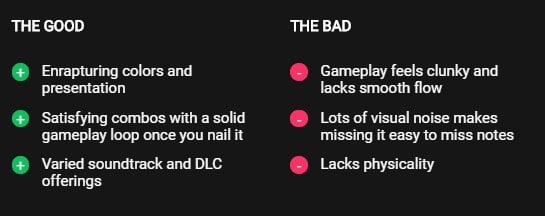
You can read more about our five-star scoring policy here.
Audica is available now on Steam for PC VR headsets, Oculus Home for Rift, PSN for PSVR and Oculus Quest at a price point of $29.99 on all platforms. This review is primarily based on the Oculus Quest version of Audica, but we’ve played it on PC via Rift and Rift S as well.
Editor’s Note: The first version of this review was published in March, 2019, when the PC Early Access version of Audica released. As of today, February 4th, 2020, the review has been updated and rewritten to account for the launch version of the game.

